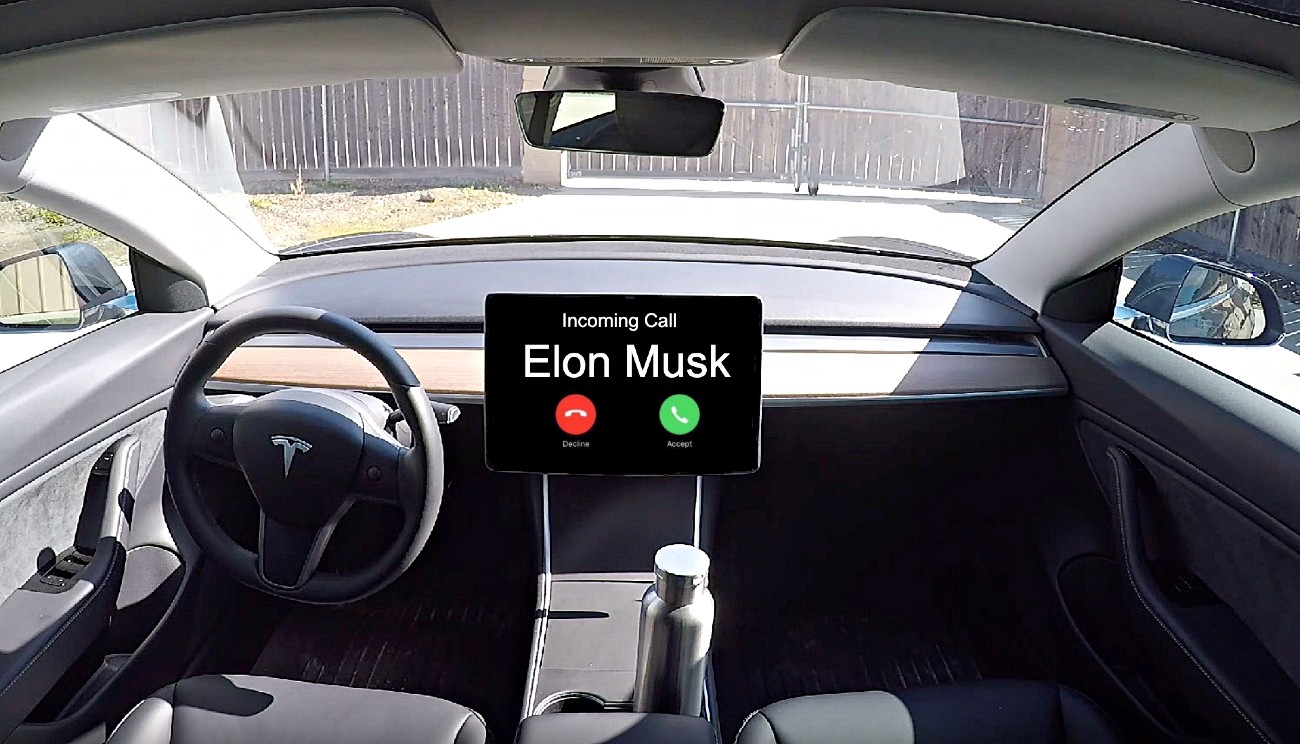Tesla has released its last three major software overhauls in September and October of 2016, 2018, and 2019 with the V8, V9, and V10 updates. With each of the new software editions, Tesla has added many new features and accessibility options to make for a more well-rounded ownership experience for drivers.
With Tesla CEO Elon Musk confirming several new features to its vehicles on Twitter, some have not yet made their way to V10 updates. This hints that they could be included in Tesla’s V11 Software Update, which was recently discussed in a video with owner-enthusiast and tech YouTuber Ben Sullins.
https://twitter.com/BenSullins/status/1318596916666511360
Sullins compiled a few examples of features that owners have requested, and Elon Musk has confirmed, but have not yet been added to the company’s vehicles. Because of this, Ben believes they could be added to Tesla’s V11 Software Update based on the timing that the previous three overhauls have been released to the public.
Vector-Space Bird’s Eye View
On October 3rd, Twitter account @TeslaOwnersSV requested that Tesla’s Driving Visualization be capable of a new “Birdseye view” feature that would give owners a perspective above their car. This would essentially give drivers a 360-degree view from above the vehicle, allowing for a full-scale indication of what surrounds their vehicle. Sullins mentions that this feature is available in the Porsche Taycan. Many Tesla owners would likely benefit from the addition of the view, simply because of the benefits of a wide-range perspective.
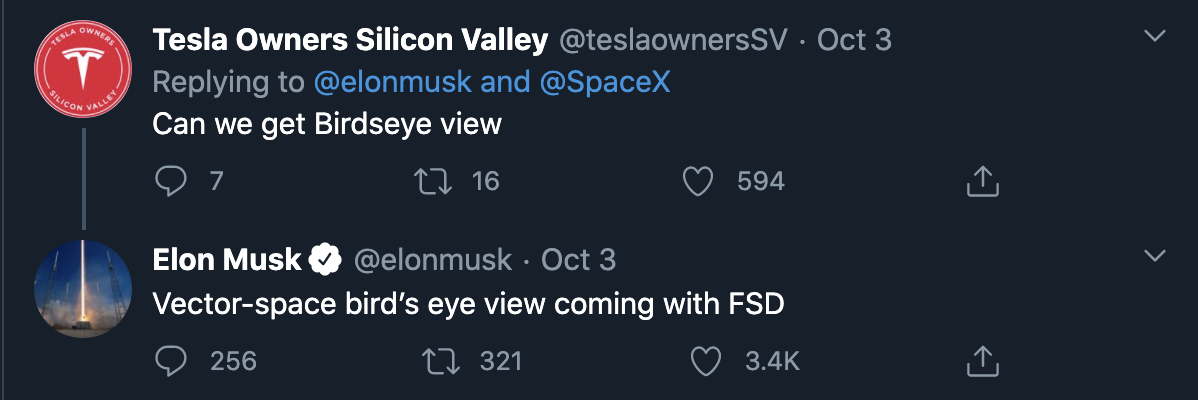
Enlarged Side Cameras for Backing Up
@ThatT3slaGuy requested that the side cameras could be enlarged while backing up, which could provide drivers with more confidence when in reverse. A single-camera setup, which only provides a view of what is directly behind the vehicle, can prove problematic in tight parking spaces where the driver’s point of view is limited. Musk confirmed that this feature would be “coming soon” on October 1st, but it has yet to be released.
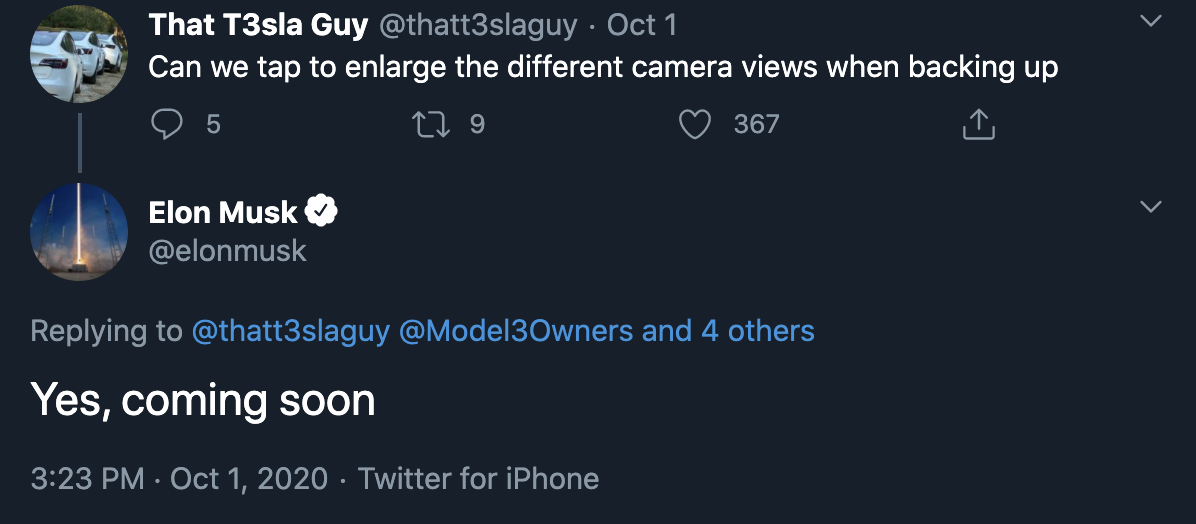
GPS Waypoints
Musk has always been a firm believer in Tesla’s GPS. When owners repeatedly requested the addition of Waypoints, he denied it time and time again. However, on September 21st, Musk finally gave owners who have been seeking the feature a glimpse of hope when he said, “Fine, we’ll do it already,” after @Model3Owners asked one final time. The addition of GPS Waypoints will give owners full customization of which route they would like to take on a trip, making for the perfect road trip.

Blind Spot Warnings/Side Repeater View with Turn Signal
Another use of the Side Repeater Cameras could be used as a Blind Spot Warning feature. @AusTeslaOwners gave Musk the idea to have the Repeater Cameras show full-screen images of what is beside the vehicle when traveling. If the driver were to be on a highway and looking to move into a lane to their left, the left turn signal would be activated, and the left-side camera would also activate and be displayed on the dash screen.
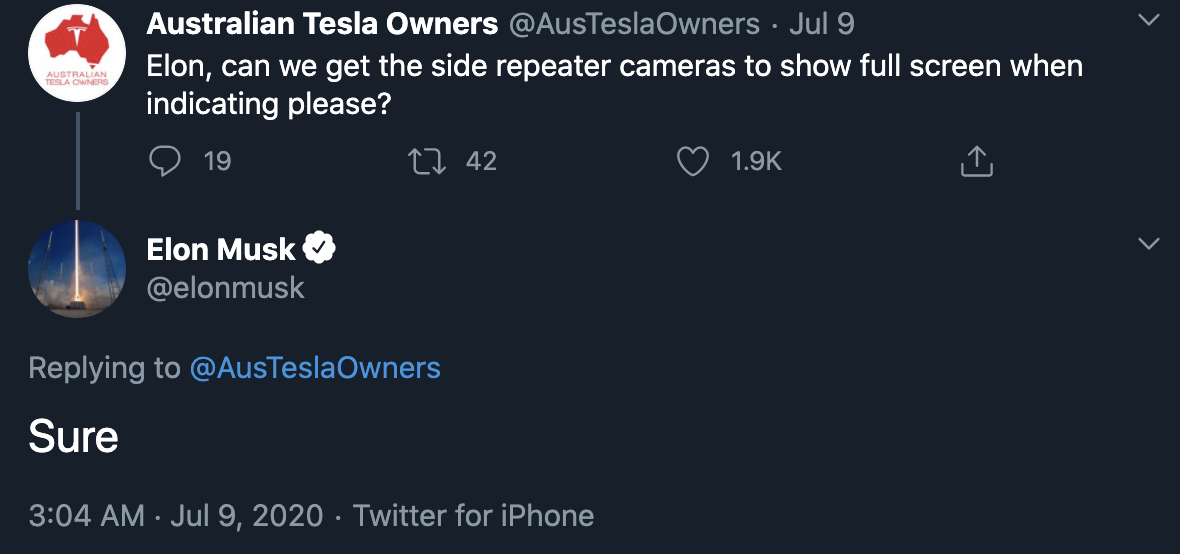
Video Conferencing inside of a Tesla
This request was also made by @TeslaOwnersSV in May. The interior cabin-facing camera that is included in the Model 3 and Model Y would allow owners to set up video conferencing from inside the vehicle. Musk stated, “Yeah, definitely a future feature,” but it has also not been added yet. Sullins believes this could be another addition to V11.
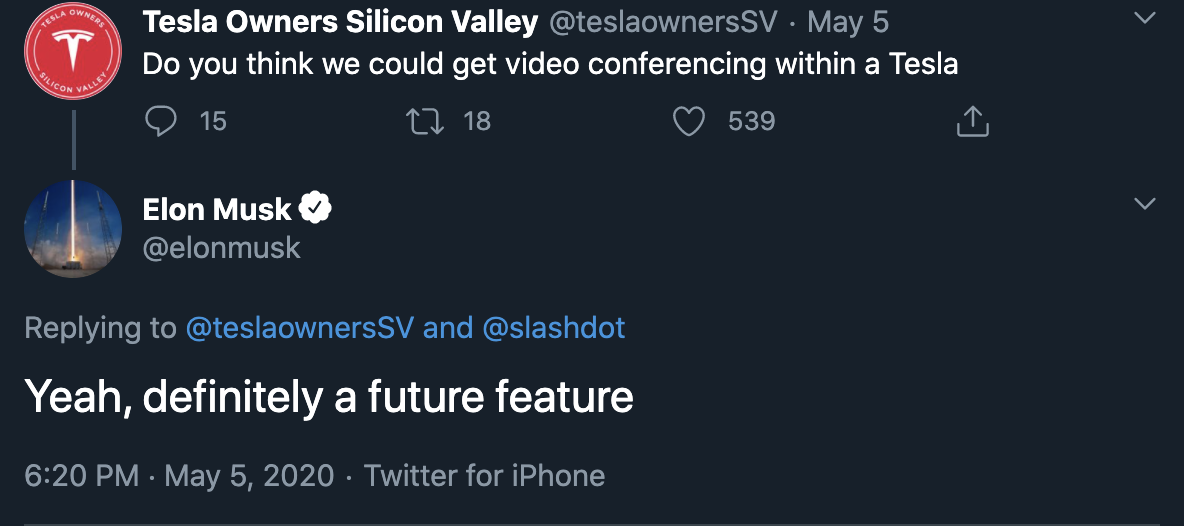
Interior Camera Activation with Sentry Mode during a break-in
@Model3Owners also suggested that the interior camera be activated during a break-in. This feature makes a lot of sense, especially if a thief is successful during their attempt to enter a Tesla. It could make the pursuit of the criminal much easier for law enforcement.
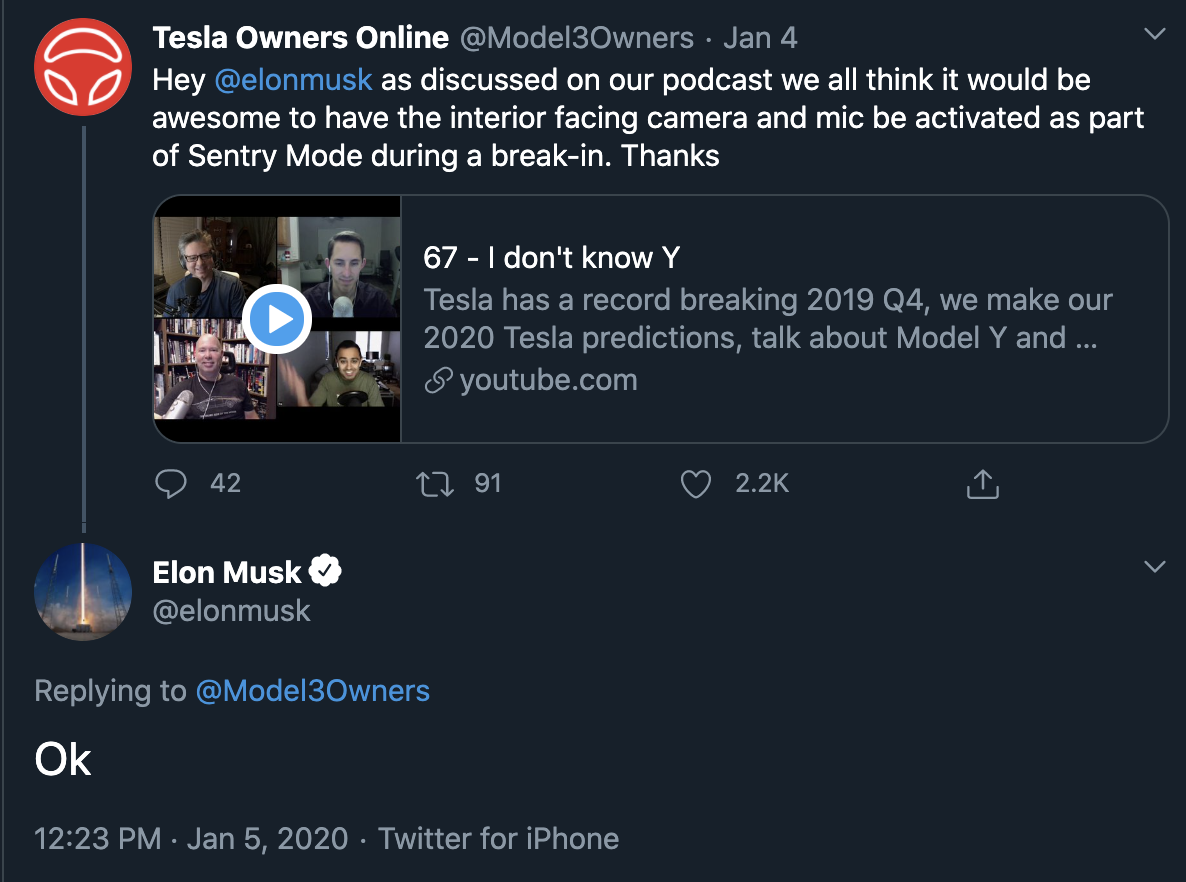
Sullins’ full video on what is coming with Tesla’s V11 Software Update is available below. Be sure to subscribe to his YouTube channel, or follow him on Twitter @BenSullins.

News
Tesla starts showing how FSD will change lives in Europe
Local officials tested the system on narrow country roads and were impressed by FSD’s smooth, human-like driving, with some calling the service a game-changer for everyday life in areas that are far from urban centers.

Tesla has launched Europe’s first public shuttle service using Full Self-Driving (Supervised) in the rural Eifelkreis Bitburg-Prüm region of Germany, demonstrating how the technology can restore independence and mobility for people who struggle with limited transport options.
Local officials tested the system on narrow country roads and were impressed by FSD’s smooth, human-like driving, with some calling the service a game-changer for everyday life in areas that are far from urban centers.
Officials see real impact on rural residents
Arzfeld Mayor Johannes Kuhl and District Administrator Andreas Kruppert personally tested the Tesla shuttle service. This allowed them to see just how well FSD navigated winding lanes and rural roads confidently. Kruppert said, “Autonomous driving sounds like science fiction to many, but we simply see here that it works totally well in rural regions too.” Kuhl, for his part, also noted that FSD “feels like a very experienced driver.”
The pilot complements the area’s “Citizen Bus” program, which provides on-demand rides for elderly residents who can no longer drive themselves. Tesla Europe shared a video of a demonstration of the service, highlighting how FSD gives people their freedom back, even in places where public transport is not as prevalent.
What the Ministry for Economic Affairs and Transport says
Rhineland-Palatinate’s Minister Daniela Schmitt supported the project, praising the collaboration that made this “first of its kind in Europe” possible. As per the ministry, the rural rollout for the service shows FSD’s potential beyond major cities, and it delivers tangible benefits like grocery runs, doctor visits, and social connections for isolated residents.
“Reliable and flexible mobility is especially vital in rural areas. With the launch of a shuttle service using self-driving vehicles (FSD supervised) by Tesla in the Eifelkreis Bitburg-Prüm, an innovative pilot project is now getting underway that complements local community bus services. It is the first project of its kind in Europe.
“The result is a real gain for rural mobility: greater accessibility, more flexibility and tangible benefits for everyday life. A strong signal for innovation, cooperation and future-oriented mobility beyond urban centers,” the ministry wrote in a LinkedIn post.
News
Tesla China quietly posts Robotaxi-related job listing
Tesla China is currently seeking a Low Voltage Electrical Engineer to work on circuit board design for the company’s autonomous vehicles.

Tesla has posted a new job listing in Shanghai explicitly tied to its Robotaxi program, fueling speculation that the company is preparing to launch its dedicated autonomous ride-hailing service in China.
As noted in the listing, Tesla China is currently seeking a Low Voltage Electrical Engineer to work on circuit board design for the company’s autonomous vehicles.
Robotaxi-specific role
The listing, which was shared on social media platform X by industry watcher @tslaming, suggested that Tesla China is looking to fill the role urgently. The job listing itself specifically mentions that the person hired for the role will be working on the Low Voltage Hardware team, which would design the circuit boards that would serve as the nervous system of the Robotaxi.
Key tasks for the role, as indicated in the job listing, include collaboration with PCB layout, firmware, mechanical, program management, and validation teams, among other responsibilities. The role is based in Shanghai.
China Robotaxi launch
China represents a massive potential market for robotaxis, with its dense urban centers and supportive policies in select cities. Tesla has limited permission to roll out FSD in the country, though despite this, its vehicles have been hailed as among the best in the market when it comes to autonomous features. So far, at least, it appears that China supports Tesla’s FSD and Robotaxi rollout.
This was hinted at in November, when Tesla brought the Cybercab to the 8th China International Import Expo (CIIE) in Shanghai, marking the first time that the autonomous two-seater was brought to the Asia-Pacific region. The vehicle, despite not having a release date in China, received a significant amount of interest among the event’s attendees.
Elon Musk
Elon Musk and Tesla AI Director share insights after empty driver seat Robotaxi rides
The executives’ unoccupied tests hint at the rapid progress of Tesla’s unsupervised Robotaxi efforts.

Tesla CEO Elon Musk and AI Director Ashok Elluswamy celebrated Christmas Eve by sharing personal experiences with Robotaxi vehicles that had no safety monitor or occupant in the driver’s seat. Musk described the system’s “perfect driving” around Austin, while Elluswamy posted video from the back seat, calling it “an amazing experience.”
The executives’ unoccupied tests hint at the rapid progress of Tesla’s unsupervised Robotaxi efforts.
Elon and Ashok’s firsthand Robotaxi insights
Prior to Musk and the Tesla AI Director’s posts, sightings of unmanned Teslas navigating public roads were widely shared on social media. One such vehicle was spotted in Austin, Texas, which Elon Musk acknowleged by stating that “Testing is underway with no occupants in the car.”
Based on his Christmas Eve post, Musk seemed to have tested an unmanned Tesla himself. “A Tesla with no safety monitor in the car and me sitting in the passenger seat took me all around Austin on Sunday with perfect driving,” Musk wrote in his post.
Elluswamy responded with a 2-minute video showing himself in the rear of an unmanned Tesla. The video featured the vehicle’s empty front seats, as well as its smooth handling through real-world traffic. He captioned his video with the words, “It’s an amazing experience!”
Towards Unsupervised operations
During an xAI Hackathon earlier this month, Elon Musk mentioned that Tesla owed be removing Safety Monitors from its Robotaxis in Austin in just three weeks. “Unsupervised is pretty much solved at this point. So there will be Tesla Robotaxis operating in Austin with no one in them. Not even anyone in the passenger seat in about three weeks,” he said. Musk echoed similar estimates at the 2025 Annual Shareholder Meeting and the Q3 2025 earnings call.
Considering the insights that were posted Musk and Elluswamy, it does appear that Tesla is working hard towards operating its Robotaxis with no safety monitors. This is quite impressive considering that the service was launched just earlier this year.
